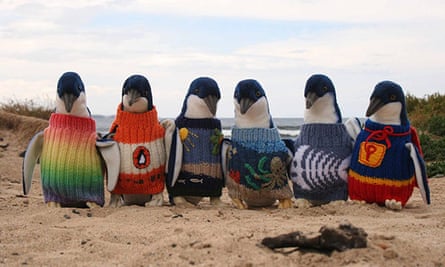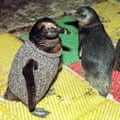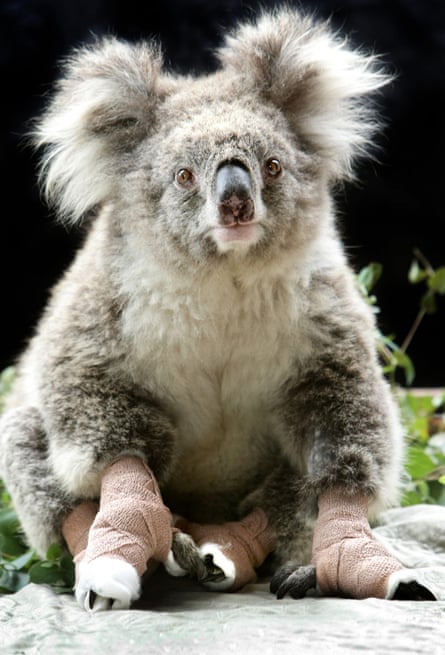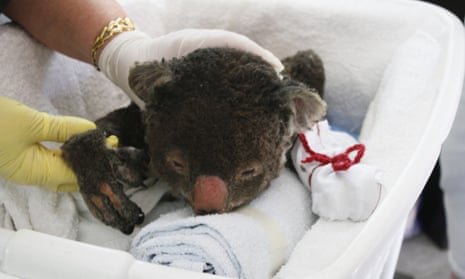There is little that is likely to stir readers more than photos of adorable animals dressed up in funny clothes. Add the element of a vulnerable species rescued from the brink of death and destruction and you have clickbait gold.
Such was the case earlier this month when one of the world’s largest animal welfare and conservation charities, International Fund for Animal Welfare (IFAW), put out a call for assistance with crafting mittens for koalas whose paws were burned in wildfires across southeastern Australia.
“Our supporters are always asking what they can do to help,” says Josey Sharrad, native wildlife campaigner for IFAW’s Australia chapter. “So [when this wildfire hit] we put a little campaign together and sent it to our supporters and local media and we posted it to Facebook.”
More than 150 media outlets – from The Guardian to Good Morning America, not to mention scores of blogs – posted irresistible IFAW photos of koalas with burned paws wearing cotton mittens. The photos were accompanied by appeals to readers to pitch in and help.
In short order, the IFAW offices were flooded with mittens. Very quickly, supply well outpaced demand. Koala-loving sewers had sent handmade mittens from as far away as Europe, Canada and the United States. Sharrad says the staff has not yet counted, but they’ve received thousands of pairs, and in response politely issued a cease and desist order to followers.
“Mitten Accomplished!” proclaimed a blog post.
Despite that, smaller outlets continued to publish the koala mitten appeal days and even weeks later.
A few large media outlets, including the Washington Post and Huffington Post, published updates that repeated the IFAW’s “thanks, but we’re good” message. But the number of these updates was small compared to the initial blitz, and most of them came a week later, when the IFAW was already inundated.
A pattern for an embarrassment of riches
It was not the first time a campaign seeking to clothe stricken animals spiraled out of control.
Two oil spills that struck “little penguin” habitats in Australia and New Zealand, in 2000 and 2011 respectively, resulted in calls for tiny homemade sweaters for the diminutive species. In each case, rescue groups solicited knitters to craft jumpers that would be used to keep the birds warm and prevent them preening and ingesting oil while they awaited a bath.
The penguin sweater pattern and accompanying story were shared far and wide.

According to Mike Dickison, curator of natural history at New Zealand’s Whanganui Regional Museum, the Tasmanian Conservation Trust alone collected 15,000 sweaters. The Penguin Foundation on Phillip Island is storing its donated sweaters in a shipping container.
The rescuers who responded to the 2011 oil spill did not use the hundreds of donated sweaters. Rather, they washed the oil from the animals and put them under heat lamps to get warm and dry (the washing removes some of the animal’s natural oils which help it stay warm).
Some of the biologists even argue that putting a sweater on an oil-soaked penguin would only serve to mat the substance into its coat and further stress the animal.

Perhaps the bigger issue is that thousands of generous handicrafters around the world may think they’re helping rescue animal species while actually doing very little – and perhaps even contributing to waste and carbon emissions. Oil slicks are only one of many threats – including death by fishing nets, predation from dogs and cats, and choking on plastic bits washing up on the beaches – that are hurting little penguin colonies.
Turning mittens to pouches?
Meanwhile, well north of the penguin rookeries, rescue workers are still caring for injured koalas, and Australia’s wildfire season is far from over. Sharrad says it’s likely than hundreds of koala have been affected.
Regardless, the IFAW’s stock of mittens will last well beyond this summer’s fires – not just because of the quantity but because, as with the penguin sweaters, rescue workers are at odds about the efficacy of homemade accessories. The Australian Marine Wildlife Research and Rescue Organization, which cares for injured koala in its wildlife clinic, had to turn away the mittens, explaining that they inhibit the animal’s ability to use their claws (instead, the group uses bandages).
“Different people have different approaches,” says Sharrad, “But we’re working with carers who do use the mittens.”
Due to the overwhelming mitten response, the IFAW has made two pivots. It is asking supporters to consider making a donation or joining their mailing list, instead of sending mittens. But it has also put out another plea for volunteer crafters, asking those who are so inclined to make cotton pouches of various sizes, which IFAW says rescue organizations use to keep juvenile (or “joey”) kangaroos and wallabies, orphaned from the fires, in a warm, clean environment, similar to their mother’s pouch. As with the mitten campaign, IFAW has included a pattern for the would-be pouch makers.

Is this the beginning of a pouch windfall? Sharrad says she does not think they will see a repeat, because IFAW has asked that only Australian residents should be making the pouches, to save on postage costs.
But it’s impossible to control where the story might be picked up.
A decade from now, IFAW and other conservation groups will likely still be storing thousands of mittens and sweaters and pouches, instead of benefiting from more valuable contributions from volunteers, such as money or advocacy for policies that help vulnerable species. The biggest threat to most species is likely a combination of habitat destruction, pollution and climate change - none of which will be solved by crafting.
Releasing a campaign into the interwebs, especially when it calls for sewing outfits or mittens for charismatic animals in need, is a great way to get outfits or mittens or pouches – all shipped via carbon-emitting parcel services.
In response to the IFAW post asking supporters to stop sending mittens, one supporter commented: “My kids spent their whole weekend making these [mittens]. You’re getting them whether you need them or not!”

Comments (…)
Sign in or create your Guardian account to join the discussion